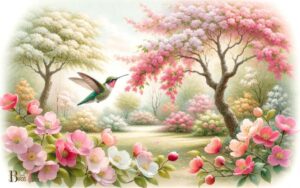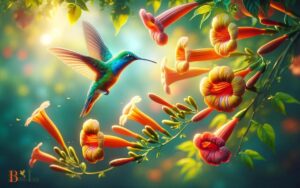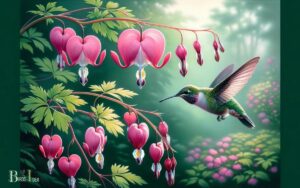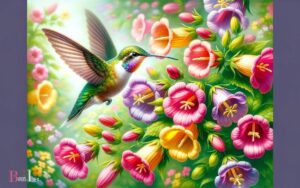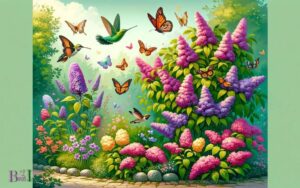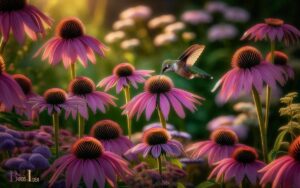Purple Flowers That Attract Hummingbirds: Lavender!
Purple flowers that attract hummingbirds include lavender, foxglove, and salvia. These blossoms provide the nectar that hummingbirds need for energy and thrive in environments that meet the birds’ habitat preferences.
Hummingbirds are drawn to flowers with high nectar content and those that are brightly colored, with purple being a particularly alluring color.
Here are some purple flowers that hummingbirds find irresistible:
Other purple flowers like petunias, verbena, and agastache also entice these birds and can transform a garden into a hummingbird haven.
Attract hummingbirds to your garden with a vivid display of purple flowers like lavender and salvia, which offer the perfect combination of nectar and color.
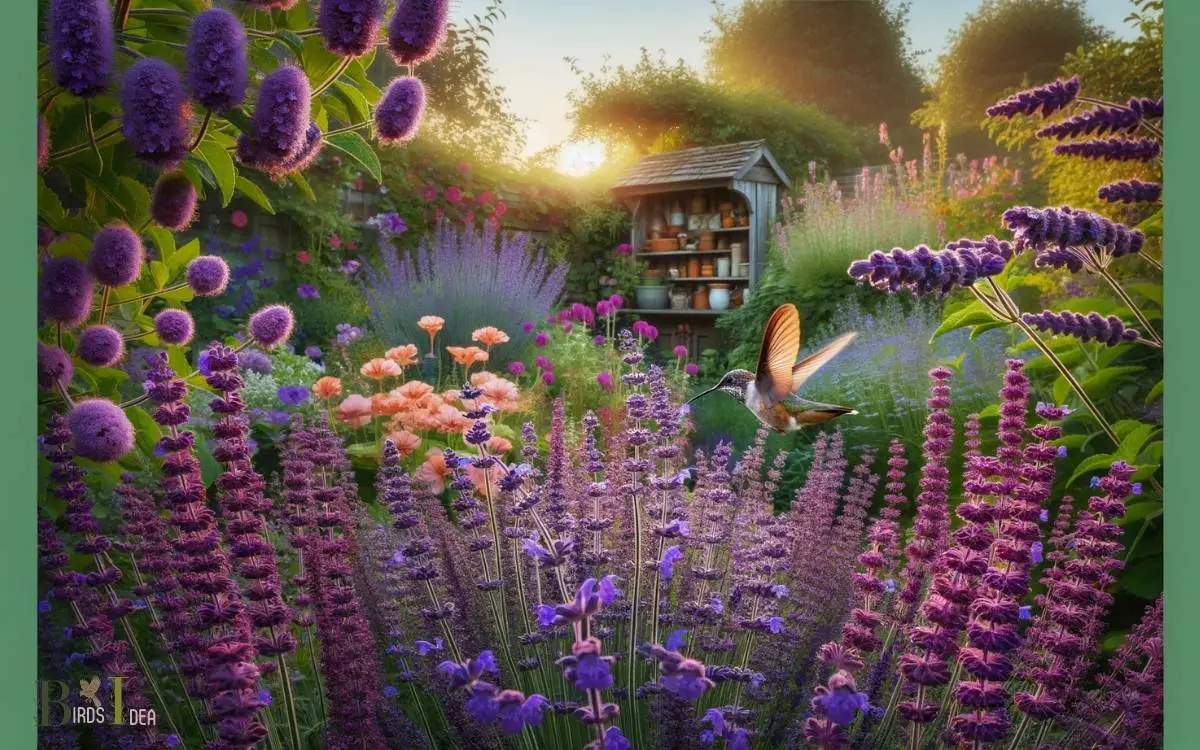
Key Takeaway
Benefits of Purple Flowers for Hummingbirds
Purple flowers provide essential nectar and attract hummingbirds to aid in pollination. Hummingbirds rely on the nectar from flowers as their primary source of energy, making purple flowers a crucial component of their diet.
The tubular shape of many purple flowers is well-suited to the long, slender beaks of hummingbirds, allowing them to easily access the nectar within.
Additionally, the vibrant color of purple flowers makes them easily visible to hummingbirds, who are attracted to bright hues.
By planting purple flowers in gardens, individuals can create a welcoming environment for hummingbirds, supporting their health and contributing to the pollination of plants.
This symbiotic relationship between purple flowers and hummingbirds is vital for the survival of both species.
This connection between purple flowers and hummingbirds underscores the importance of selecting the best purple flowers for hummingbird gardens.
Best Purple Flowers for Hummingbird Gardens
When selecting the best purple flowers for hummingbird gardens, it is important to consider the specific attributes that make certain varieties particularly appealing to these fascinating birds.
One excellent choice is the Salvia, also known as sage. This perennial plant produces lovely purple flowers that are rich in nectar, attracting hummingbirds with their sweet taste.
Another great option is the Butterfly Bush, which not only comes in various shades of purple but also blooms in long clusters, providing ample feeding opportunities for hummingbirds.
The Penstemon, with its tubular purple flowers, is also a favorite among hummingbirds due to its abundant nectar.
Finally, the Cardinal Flower, with its striking, deep purple blooms, is highly attractive to hummingbirds and adds vibrant color to any garden.
Planting and Caring for Purple Hummingbird Flowers
When planting and caring for purple hummingbird flowers, it’s important to consider their soil and watering needs, as well as their preferences for sunlight and shade.
Understanding the specific requirements of these flowers will help ensure their successful growth and ability to attract hummingbirds to the garden.
By providing the right conditions, gardeners can create a welcoming environment for both the flowers and the hummingbirds they seek to attract.
Soil and Watering Needs
To ensure the health and vibrancy of purple hummingbird flowers, gardeners should choose well-draining soil and water deeply but infrequently to encourage deep root growth.
Well-draining soil is essential as it prevents water from accumulating around the roots, which can lead to rot and other issues. A mixture of organic matter, such as compost, can also improve soil drainage and fertility.
When it comes to watering, a deep soak once a week is generally sufficient for most purple flowering plants. This encourages the roots to grow downward in search of water, making the plants more resilient during dry spells.
However, it’s important to adjust watering based on specific plant needs and local climate conditions. By paying attention to soil quality and watering habits, gardeners can help their purple hummingbird flowers thrive.
Sunlight and Shade Preferences
Preferring bright sunlight, purple hummingbird flowers thrive in well-drained soil with minimal shade, attracting hummingbirds with their vibrant blooms.
When planting and caring for these flowers, it’s essential to consider their sunlight and shade preferences.
Here are some key points to keep in mind:
- Sunlight Requirements: Purple hummingbird flowers require at least 6-8 hours of sunlight daily to bloom abundantly.
- Shade Tolerance: While these flowers prefer sunlight, they can tolerate some light afternoon shade, especially in hot climates.
- Avoiding Dense Shade: It’s crucial to avoid planting these flowers in areas with dense shade, as it can hinder their growth and reduce flower production.
Understanding the sunlight and shade preferences of purple hummingbird flowers is crucial for their successful cultivation. This knowledge sets the stage for creating an ideal habitat to attract hummingbirds.
Creating a Purple Flower Hummingbird Habitat
Hummingbirds prefer a habitat with a variety of purple flowers to provide them with nectar throughout the season.
When creating a purple flower hummingbird habitat, it’s essential to select a range of purple flowers that bloom at different times, ensuring a continuous nectar supply.
Some excellent choices for a hummingbird garden include lavender, salvia, bee balm, and butterfly bush.
These flowers not only provide nectar but also offer a visual attraction for the hummingbirds. It’s important to consider the location of the garden, ensuring that it receives adequate sunlight and has shelter from strong winds.
Additionally, maintaining a pesticide-free environment is crucial to ensure the safety of the hummingbirds.
By incorporating these elements, one can create a thriving purple flower hummingbird habitat.
Purple Flower Varieties to Attract Hummingbirds
When it comes to attracting hummingbirds, certain purple flower varieties stand out as the best choices.
These plants not only add a pop of color to the garden but also provide the nectar that hummingbirds love.
By selecting easy-care hummingbird flowers in shades of purple, gardeners can create a welcoming habitat that will delight both the birds and the human observers.
Best Purple Hummingbird Plants
Among the best purple hummingbird plants, one popular choice is the Salvia guaranitica, known for its vibrant purple flowers that attract these agile creatures.
This perennial plant blooms from early summer to the first frost, providing a long-lasting food source for hummingbirds.
Another excellent option is the Verbena bonariensis, a tall, slender plant with clusters of small purple flowers that hummingbirds find irresistible.
Lastly, the Agastache, also known as hyssop, is a favorite of hummingbirds due to its tubular purple flowers and long blooming period.
These plants not only add a splash of color to the garden but also serve as vital nectar sources for hummingbirds, making them a valuable addition to any hummingbird-friendly garden.
Easy-Care Hummingbird Flowers
Easy-care purple flower varieties that attract hummingbirds include some popular choices like Salvia guaranitica, Verbena bonariensis, and Agastache, known for their vibrant blooms and long-lasting nectar sources.
These plants are low-maintenance and perfect for those seeking to attract hummingbirds without extensive upkeep.
Salvia guaranitica, also known as Anise Sage, produces stunning deep purple flowers that bloom from summer to fall, making it an excellent choice for a constant nectar source.
Verbena bonariensis, commonly known as Purpletop Vervain, offers tall, slender stems topped with clusters of small purple flowers that hummingbirds find irresistible.
Agastache, or Hummingbird Mint, is another favorite, with its aromatic foliage and long-blooming purple spikes.
These easy-care options provide an effortless way to invite hummingbirds into the garden.
Designing a Stunning Purple Flower Garden
To create a stunning purple flower garden, gardeners should carefully select a variety of purple blooms that complement each other in color, size, and blooming season.
This ensures a visually appealing and well-balanced garden that will attract hummingbirds and provide enjoyment throughout the growing season.
Here are some key considerations for designing a beautiful purple flower garden:
- Variety: Choose a diverse selection of purple flowers, including different shapes and sizes, to create visual interest and depth in the garden.
- Blooming Seasons: Select flowers that bloom at different times throughout the growing season to ensure continuous color and nectar supply for hummingbirds.
- Complementary Colors: Incorporate complementary colors such as white, pink, and blue to enhance the overall aesthetic and create a harmonious blend within the garden.
Tips for Attracting Hummingbirds With Purple Blooms
Attracting hummingbirds with purple blooms involves strategically planting and maintaining a variety of nectar-rich flowers in the garden.
When selecting purple blooms, it’s essential to choose flowers that produce abundant nectar, such as lavender, salvia, and bee balm.
These flowers provide the high-energy food source that hummingbirds need. It’s important to plant a mix of early, mid, and late blooming purple flowers to ensure a consistent nectar supply throughout the hummingbird season.
Additionally, incorporating a variety of flower shapes and sizes will appeal to a broader range of hummingbird species.
To maximize the attraction of hummingbirds, it’s crucial to maintain the flowers by deadheading, watering, and fertilizing them regularly.
By providing a diverse and well-maintained selection of purple blooms, gardeners can create a haven for hummingbirds in their gardens.
Maintaining a Thriving Purple Flower Hummingbird Garden
One important aspect of maintaining a thriving purple flower hummingbird garden is to regularly deadhead and fertilize the flowers to ensure a continuous nectar supply for the hummingbirds.
This helps in sustaining an environment that attracts and supports the hummingbird population.
In addition to deadheading and fertilizing, the following practices are essential for maintaining a flourishing purple flower hummingbird garden:
- Prune Regularly: Regular pruning helps in promoting new growth and keeps the garden tidy, providing easy access to the nectar-filled flowers for hummingbirds.
- Provide Water Sources: Incorporating water features such as birdbaths or small fountains can attract hummingbirds by providing them with a water source for drinking and bathing.
- Control Pests: Regular inspection for pests and implementing appropriate pest control measures is crucial to prevent damage to the flowers and maintain a healthy garden environment for hummingbirds.
Conclusion
Planting purple flowers to attract hummingbirds is a beautiful and beneficial endeavor. The vibrant hues and sweet nectar of these blooms bring blissful birds to your backyard.
By creating a captivating and colorful habitat, you can ensure the presence of these delightful creatures.
So, don’t delay, dive into designing a dazzling and dynamic purple flower garden to delight in the delightful dance of hummingbirds.

